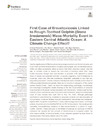Identificador persistente para citar o vincular este elemento:
https://accedacris.ulpgc.es/jspui/handle/10553/114291
| Título: | First Case of Brevetoxicosis Linked to Rough-Toothed Dolphin (Steno bredanensis) Mass-Mortality Event in Eastern Central Atlantic Ocean: A Climate Change Effect? | Autores/as: | Fernández Rodríguez, Antonio Jesús Sierra Pulpillo, Eva María Arbelo Hernández, Manuel Antonio Gago Martínez, Ana Leao Martins, Jose Manuel García Álvarez, Natalia Bernaldo De Quirós Miranda, Yara Arregui Gil, Marina Vela, Ana Isabel Díaz-Delgado, Josué |
Clasificación UNESCO: | 32 Ciencias médicas 3214 Toxicología 3109 Ciencias veterinarias |
Palabras clave: | Biotoxin Climate Change Harmful Algal Bloom Karenia Brevis Pbtx |
Fecha de publicación: | 2022 | Proyectos: | Patologia Embolica (Gaseosa/Grasa) en Cetaceos (Pegcet-3) Red Macaronésica de transferencia de conocimientos y tecnologías interregional y multidisciplinar para proteger, vigilar y monitorizar los cetáceos y el medio marino, y analizar y explotar de forma sostenible la actividad turística asociada Fomento de la actividad ecoturística de whale watching como modelo de desarrollo económico sostenible mediante la protección y conservación de las poblaciones de cetáceos y su puesta en valor como patrimonio natural de la Macaronesia |
Publicación seriada: | Frontiers in Marine Science | Resumen: | Harmful algal blooms (HABs) have been increasingly recorded over the last decades and much work has linked these events to multiple oceanographic and climate disturbances. HABs can affect ecosystems either as events that affect dissolved oxygen, clog fish gills, or smother corals or through the production of biotoxins which affect living marine resources through food web transfers or aerosols. HAB represent a natural driver of decline and potential extinction of aquatic organisms, from invertebrates to mammals, which may offer little evolutionary adaptation particularly in very high and long-lasting exposures. Despite numerous multispecies mass-mortality events linked to HAB-associated biotoxicosis globally, there are no records in cetaceans off the central eastern Atlantic Ocean. Herein, we report the epidemiology, pathologic, microbiologic and toxicologic investigation results attesting to the first documentation of cetacean mass-mortality in European waters associated with brevetoxins. Twelve rough-toothed dolphins (Steno bredanensis) were found dead adrift or beached along the southwestern coast of Gran Canaria from April 28th to May 7th, 2008. Although pathologic examinations were limited by moderate to advanced autolysis and decomposition of the carcasses, consistent findings included multisystemic hemorrhage and undigested ingesta within the gastric compartments, mainly salema porgy (Sarpa salpa). Toxicologic analysis of gastric contents identified PbTx2 and PbTx3 brevetoxins. Our results provide compelling toxicopathologic evidence of fatal brevetoxicosis in a cohort of rough-toothed dolphins. These data add to the limited knowledge on pathology of HAB in cetaceans and provide the first account of brevetoxicosis in European waters. No other mass-mortality or individual fatality of any cetacean species has been linked to brevetoxicosis in the Canary Islands since this event. | URI: | https://accedacris.ulpgc.es/handle/10553/114291 | ISSN: | 2296-7745 | DOI: | 10.3389/fmars.2022.834051 | Fuente: | Frontiers in Marine Science [EISSN 2296-7745], v. 9, (Febrero 2022) |
| Colección: | Artículos |
Citas SCOPUSTM
10
actualizado el 08-jun-2025
Citas de WEB OF SCIENCETM
Citations
7
actualizado el 08-jun-2025
Visitas
188
actualizado el 17-may-2025
Descargas
113
actualizado el 17-may-2025
Google ScholarTM
Verifica
Altmetric
Comparte
Exporta metadatos
Los elementos en ULPGC accedaCRIS están protegidos por derechos de autor con todos los derechos reservados, a menos que se indique lo contrario.
